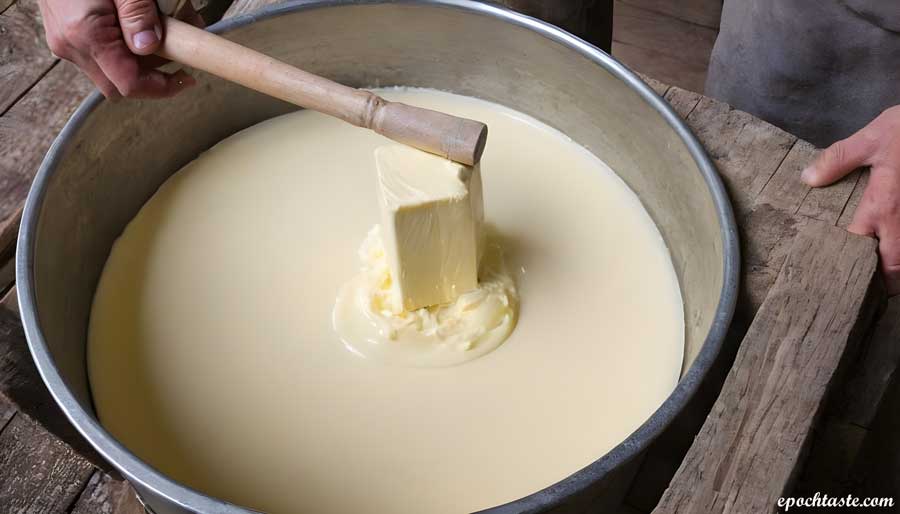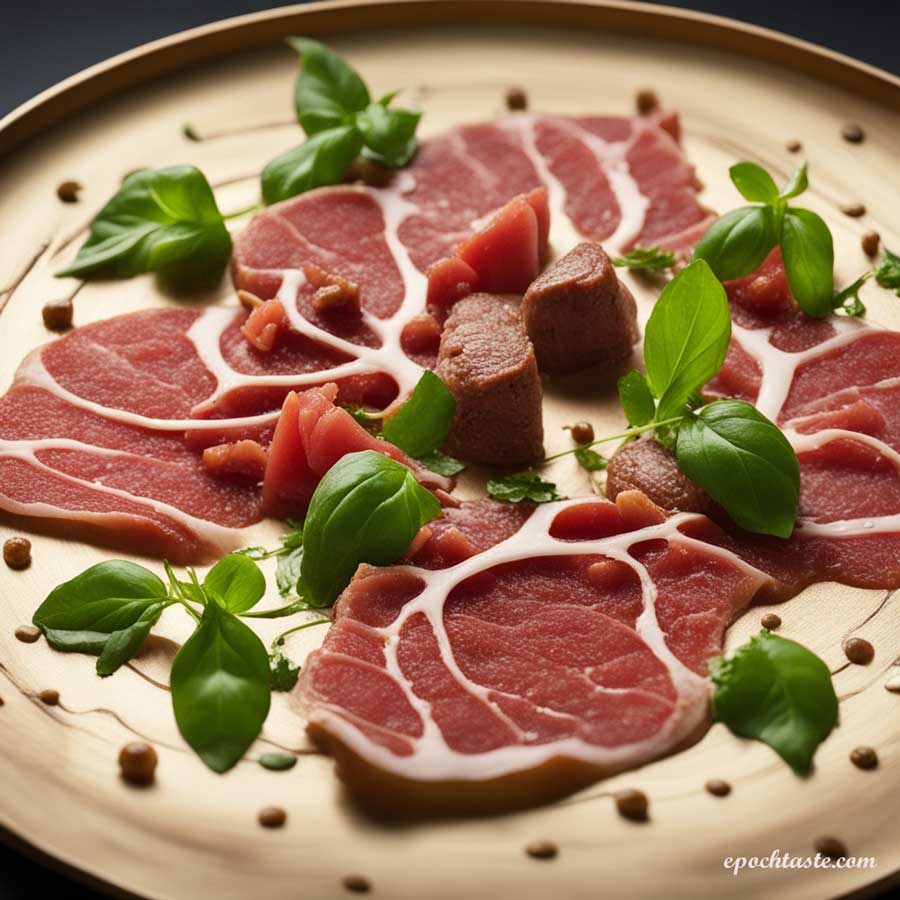Buttermilk, with its tangy flavor and versatility in the kitchen, has been a staple in culinary traditions around the world for centuries. While many consider it a byproduct of butter production, buttermilk is a delightful ingredient in its own right. In this comprehensive guide, we will explore the fascinating journey of how buttermilk is made. From traditional methods to modern techniques, we’ll also delve into its various uses in cooking and provide easy recipes. By the end of this journey, you’ll have a deep understanding of what buttermilk is, how to make it at home, and how to incorporate it into your culinary repertoire.
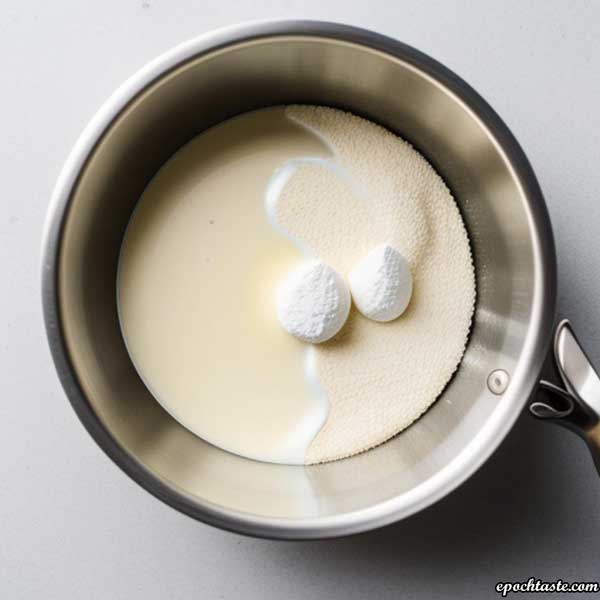
Table of Contents
- Demystifying Buttermilk: What Is It?
- Understanding the Origins
- Variations of Buttermilk
- Traditional Buttermilk Production: Churning Butter
- The Role of Cream
- The Churning Process
- Modern Buttermilk Production: Cultured Buttermilk
- Fermentation and Cultures
- Shelf-Stable Buttermilk
- How to Make Buttermilk at Home
- The Classic Method
- Using Yogurt or Curd
- From Heavy Cream
- Measurements: How to Make 100ml Buttermilk or 1/2 Cup Buttermilk
- Where to Buy Buttermilk
- Supermarkets and Grocery Stores
- Local Dairies and Creameries
- What Is Buttermilk Good For?
- Culinary Uses
- Health Benefits
- Easy Recipes with Buttermilk
- Classic Buttermilk Pancakes
- Buttermilk Fried Chicken
- Buttermilk Ranch Dressing
- Conclusion: Embracing Buttermilk’s Delightful Journey
Chapter 1: Demystifying Buttermilk: What Is It?
Understanding the Origins
Buttermilk’s name can be somewhat misleading because it isn’t directly derived from milk but rather from the process of making butter. Traditionally, buttermilk is the liquid left behind after churning butter from cream. It’s a result of the separation of fat from milk.
Variations of Buttermilk
There are two main types of buttermilk:
- Traditional Buttermilk: This is the liquid left after churning butter from cultured cream. It has a pleasant tangy flavor and is often used in cooking and baking.
- Cultured Buttermilk: More commonly found today, this type of buttermilk is made by fermenting low-fat or skim milk with specific lactic acid bacteria cultures. It is what most people think of when they refer to buttermilk, and it’s often used in recipes.
In the following chapters, we’ll explore both traditional and modern methods of making buttermilk.
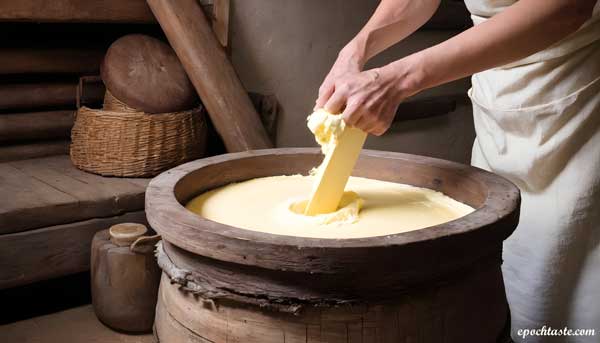
Chapter 2: Traditional Buttermilk Production: Churning Butter
The Role of Cream
Traditional buttermilk is a byproduct of the butter-making process. It begins with fresh cream, which can come from cow’s milk, goat’s milk, or other sources. The cream is left to naturally separate into two components: butterfat (the solid portion) and buttermilk (the liquid portion).
The Churning Process
- Cream is left to ripen slightly, allowing natural bacteria to develop. This ripening process contributes to the tangy flavor of buttermilk.
- The cream is churned vigorously, causing the fat molecules to clump together and form butter.
- As the fat separates from the cream, the leftover liquid becomes buttermilk.
This traditional buttermilk has a rich, tangy taste and was historically used in various culinary applications, including baking and as a refreshing beverage.
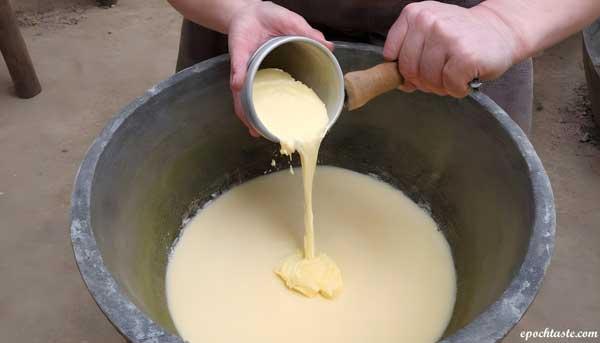
Chapter 3: Modern Buttermilk Production: Cultured Buttermilk
Fermentation and Cultures
Modern cultured buttermilk is made by fermenting low-fat or skim milk with specific lactic acid bacteria cultures. This fermentation process converts lactose (milk sugar) into lactic acid, giving buttermilk its characteristic tangy flavor.
Shelf-Stable Buttermilk
Cultured buttermilk is typically pasteurized and can be found on store shelves as a shelf-stable product. It has a consistent flavor and texture, making it a reliable choice for recipes.
This cultured buttermilk is widely available and is often used in cooking and baking.

Chapter 4: How to Make Buttermilk at Home
The Classic Method
To make buttermilk at home using the classic method, you’ll need:
- Heavy cream
Steps:
- Pour heavy cream into a glass jar or container with a lid, leaving some room at the top for expansion.
- Seal the container and shake it vigorously for about 15-20 minutes until the fat separates from the liquid. You’ll see small clumps of butter forming.
- Strain the liquid to separate the buttermilk from the butterfat. You can use a fine-mesh strainer or cheesecloth.
- Store the buttermilk in a separate container and refrigerate it for use in recipes.
Using Yogurt or Curd
Another simple method to make buttermilk at home is by using yogurt or curd. Here’s how:
- Take a cup of yogurt or curd.
- Dilute it with an equal amount of water and mix well.
- This mixture can be used as a substitute for buttermilk in recipes.
From Heavy Cream
You can also make buttermilk by combining heavy cream and milk. Here’s how to make 1/2 cup of buttermilk:
- Take 1/4 cup of heavy cream and pour it into a measuring cup.
- Add 1/4 cup of milk to the same measuring cup.
- Stir the mixture well to combine.
These homemade buttermilk variations can be used in recipes just like store-bought buttermilk.
Chapter 5: Measurements: How to Make 100ml Buttermilk or 1/2 Cup Buttermilk
To make a specific quantity of buttermilk, such as 100ml or 1/2 cup, you can use the following measurements:
For 100ml of buttermilk:
- Take 50ml of heavy cream.
- Add 50ml of milk and mix them together.
For 1/2 cup of buttermilk:
- Take 1/4 cup of heavy cream.
- Add 1/4 cup of milk and mix them together.
These measurements ensure you have the right amount of buttermilk for your recipes.
Chapter 6: Where to Buy Buttermilk
Supermarkets and Grocery Stores
Most supermarkets and grocery stores carry buttermilk in their dairy section. It’s typically available in cartons or plastic bottles. Cultured buttermilk is the most common type you’ll find on store shelves.
Local Dairies and Creameries
If you prefer artisanal or locally sourced products, you may be able to find buttermilk from local dairies or creameries. These products may have unique flavors and characteristics.
You can choose the option that best suits your needs and preferences, whether it’s convenience from a supermarket or the charm of a local product.
Chapter 7: What Is Buttermilk Good For?
Culinary Uses
Buttermilk is a versatile ingredient in the kitchen, known for its ability to:
- Add a tangy flavor to baked goods like pancakes, biscuits, and muffins.
- Tenderize meat in marinades for dishes like fried chicken.
- Act as a leavening agent when combined with baking soda in recipes.
- Enhance the creaminess of salad dressings and dips.
Health Benefits
Buttermilk also offers several potential health benefits, such as:
- Probiotics: Cultured buttermilk contains probiotics that support gut health.
- Nutrient-Rich: It’s a good source of calcium, vitamin B12, and other essential nutrients.
- Low in Fat: Low-fat and fat-free buttermilk options are available for those watching their fat intake.
Buttermilk is not only delicious but can also be a nutritious addition to your diet.
Chapter 8: Easy Recipes with Buttermilk
Classic Buttermilk Pancakes
Ingredients:
- 1 cup all-purpose flour
- 2 tablespoons sugar
- 1 teaspoon baking powder
- 1/2 teaspoon baking soda
- 1/4 teaspoon salt
- 1 cup buttermilk
- 1 egg
- 2 tablespoons melted butter
- Cooking spray
Steps:
- In a mixing bowl, whisk together the flour, sugar, baking powder, baking soda, and salt.
- In another bowl, whisk the buttermilk, egg, and melted butter.
- Pour the wet ingredients into the dry ingredients and stir until just combined.
- Heat a griddle or non-stick skillet over medium-high heat and lightly coat it with cooking spray.
- Pour 1/4 cup portions of the batter onto the griddle and cook until bubbles form on the surface, then flip and cook until golden brown.
- Serve with your favorite toppings.
Buttermilk Fried Chicken
Ingredients:
- 8 pieces of chicken (legs and thighs)
- 2 cups buttermilk
- 2 cups all-purpose flour
- 1 tablespoon paprika
- 1 teaspoon cayenne pepper
- 1 teaspoon garlic powder
- Salt and pepper to taste
- Vegetable oil for frying
Steps:
- In a large bowl, soak the chicken pieces in buttermilk for at least 1 hour or overnight in the refrigerator.
- In another bowl, mix the flour, paprika, cayenne pepper, garlic powder, salt, and pepper.
- Heat vegetable oil in a deep skillet or frying pan to 350°F (175°C).
- Dredge the buttermilk-soaked chicken in the seasoned flour mixture, ensuring even coating.
- Fry the chicken in batches until golden brown and the internal temperature reaches 165°F (74°C).
- Drain on paper towels and serve hot.
Buttermilk Ranch Dressing
Ingredients:
- 1/2 cup buttermilk
- 1/2 cup mayonnaise
- 1/2 cup sour cream
- 1 teaspoon garlic powder
- 1 teaspoon onion powder
- 1 teaspoon dried dill
- 1 teaspoon dried parsley
- Salt and pepper to taste
Steps:
- Whisk together the buttermilk, mayonnaise, and sour cream until smooth.
- Add the garlic powder, onion powder, dried dill, dried parsley, salt, and pepper. Stir until well combined.
- Refrigerate for at least 30 minutes to allow the flavors to meld.
- Serve as a salad dressing or dip.
These recipes showcase the versatility of buttermilk in both sweet and savory dishes.
Chapter 9: Conclusion: Embracing Buttermilk’s Delightful Journey
In conclusion, buttermilk is a remarkable ingredient with a rich history and a wide range of culinary uses. Whether you choose traditional buttermilk from churning butter or modern cultured buttermilk, you can enjoy its tangy flavor and health benefits in various recipes. From classic buttermilk pancakes to crispy fried chicken and creamy ranch dressing, the possibilities are endless. By understanding how buttermilk is made and its culinary potential, you can elevate your cooking and savor the magic of this delightful dairy product. Happy cooking!

